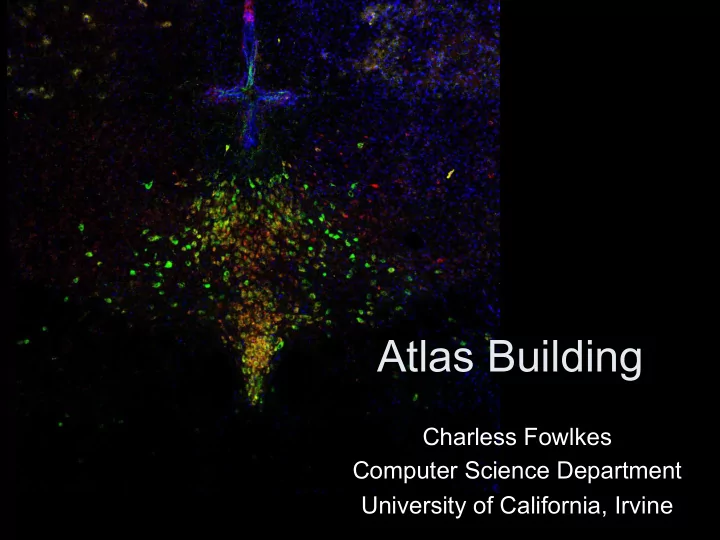

Atlas Building Charless Fowlkes Computer Science Department University of California, Irvine
Optical mapping and atlases • Improved methods for labeling, clearing and optical imaging place cellular-resolution whole brain acquisition within reach even for small labs without titanic resources. • Computational outlook: need data structures and algorithms for capturing, curating and querying spatial data • General types of queries: – What cell types are present in a particular area? – What other regions do these neurons project to? – Are these two cell populations directly connected?
Allen Mouse Brain Atlas • Mechanically sectioned, computational registration based on large scale anatomical features • Gene expression ( in situ ) and projection data (rAAV + Cre) • Very large scale!
Registration and Correspondence Align data collected across different experiments into a standardized spatio-temporal coordinate system Correspondences between samples is the key: – Composite / average measurements across experiments – Factor out unimportant modes of spatial variability when making comparisons among individuals – Measure and characterize remaining variability
Drosophila gene expression atlas [Fowlkes, et. al., Cell , 2008]
Embryo shape and number of cells varies
D. melanogaster � D. pseudoobscura � [Fowlkes, et. al., PLoS Genetics, 2011]
How do you represent correspondence and assemble a comprehensive, cellular-resolution description of the brain when the tissue is heterogeneous and there is no simple one-to-one mapping between functionally equivalent circuits? 3. How do I find the best 1. What are the correspondence between characteristics and samples? functional consequence of biological variation? 2. How should I represent morphological and other spatio-termporal data?
1. Understanding Variability • What are the modes of variation in spatial organization (cell morphology, genetics, circuits, activity, development) across individuals? • How does function depend (or not) on these differences? • In what way would we expect comprehensive maps of the brain to represent individual variation? Does a mean or “typical” connectome make any sense?
2. Spatial Representations distribution of anatomical circuit wiring cell morphology subcellular components shape shape-like ????? texture-like • Variability/stochasticity in spatial organization has different characteristics at different spatio-temporal scales • How do we represent these different types of information in a common computational framework? What are the criteria for deciding if we are using the "right” representations?
3. Robust computational tools • How do we get quantitative mapping data to interact computationally with new experimental data collected by individual labs? • Are atlases only built by specialized, large-scale efforts or could they be assembled from more heterogeneous data collected by the “long tail” of small labs focused on specific research questions? • Need robust pipelines for extracting quantitative morphological descriptions from images and aligning them to atlases. Opportunities for user-trainable and human-in-the- loop approaches to automating data analysis and curation
Recommend
More recommend